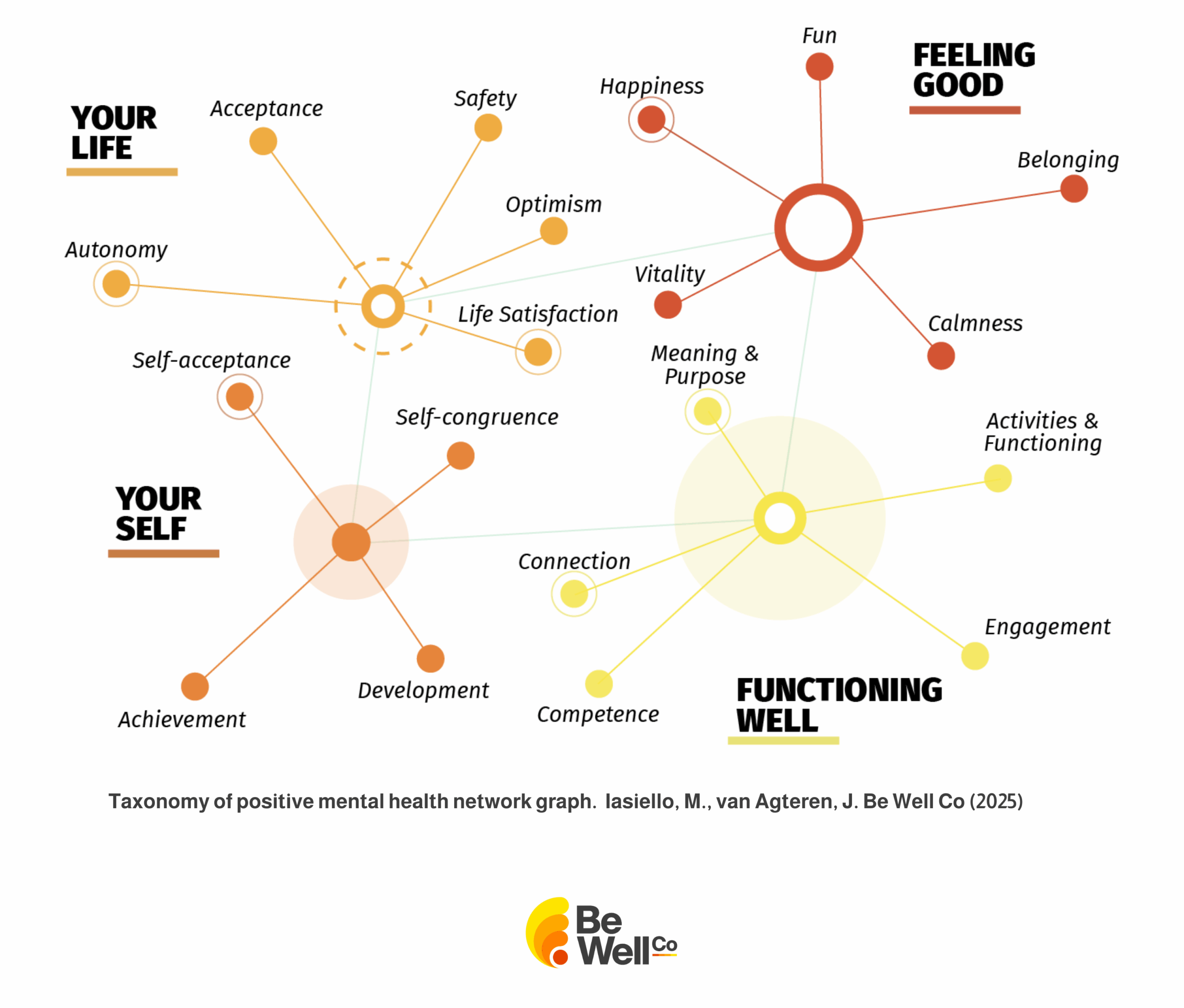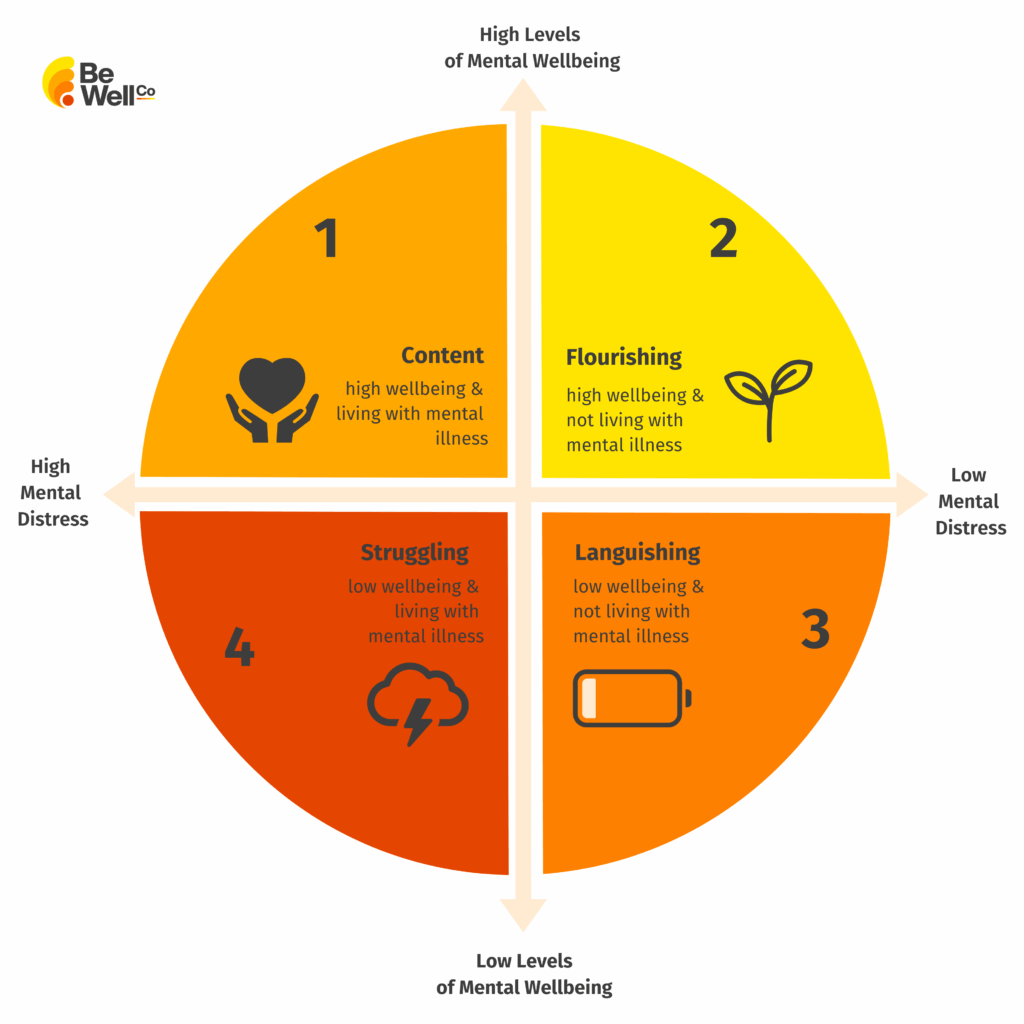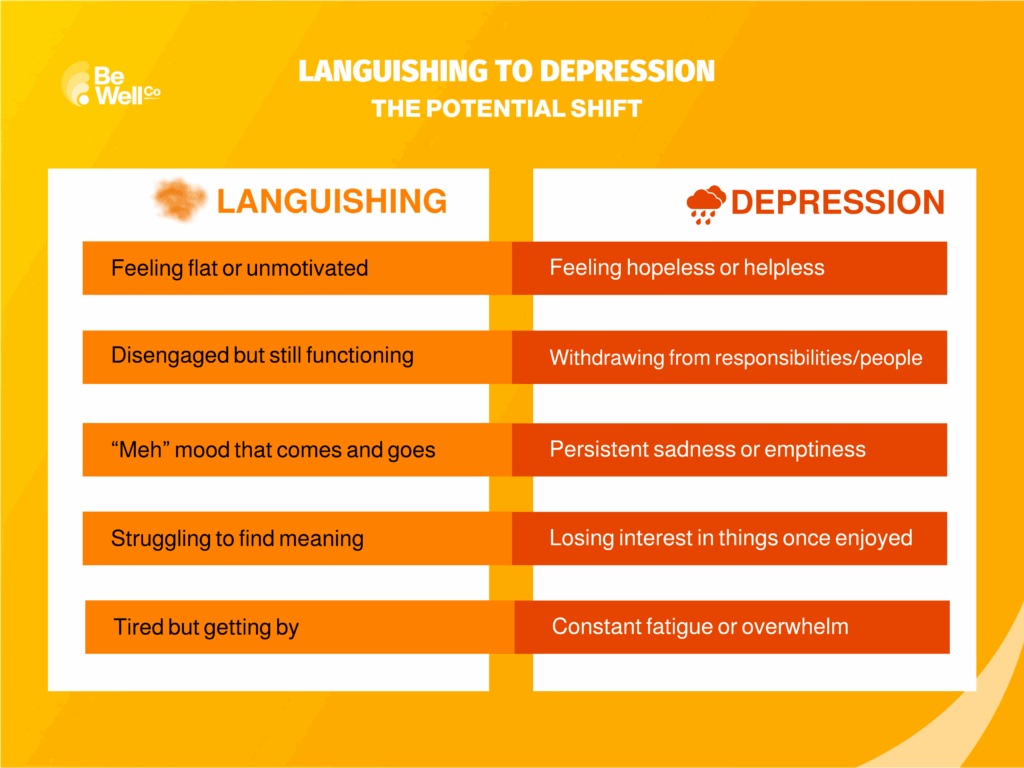How languishing differs from depression and what you can do
You’ve heard of depression, maybe you’ve heard of languishing – but what’s the difference? And do we know when low mood or a lack of motivation crosses the line into something more serious?
In this article, we will explore how mental health and wellbeing are distinct but related, how to recognise the signs of both languishing and depression, how to tell the difference, and what steps you can take to proactively support your mental health.
Languishing vs depression
This is a common question we get, and when you’re first reading about languishing you might wonder what the difference is. We’ve written an entirely other blog post on it, and it’s one of our most read articles of the year. Check it out below.
The spectrum of mental health
Traditionally, we’ve thought of mental health as a simple spectrum: you’re either mentally ill or you’re mentally well. But the reality is more complex. Mental health isn’t just the absence of illness, it also includes the presence (or absence) of wellbeing.
This example reflects research by Corey Keyes, who proposed the dual continua model of mental health. His work shows that mental illness and mental wellbeing are not opposite ends of a single spectrum but are distinct, co-existing dimensions (see below!).
That’s why we need to shift from thinking of mental health on a single spectrum “ill” or “well” and instead recognise four distinct categories:
- Struggling
- Languishing
- Content
- Flourishing
Let’s take Sarah, for example. Sarah lives with depression. She often feels deep sadness, low motivation, and sometimes struggles to focus. But she also has a strong support network, finds purpose in her work, and feels hopeful about her future. This is an example of content. She has a diagnosable disorder (depression) but is managing her mental illness while still experiencing positive mental wellbeing.
On the other hand, we have Sunil. Sunil doesn’t have a diagnosed mental illness, but he’s far from thriving. He’s worked the same job for five years, and while it’s stable, he finds it monotonous and uninspiring. Life feels like it’s on pause. He avoids social plans, not because he’s upset, but because he feels emotionally flat and disconnected. He often describes his days as “meh.” Sunil is languishing, not unwell enough to feel he should seek help, but not well enough to feel like he’s living a fulfilled life.
The key we need to recognise from this framework is:
- Mental illness and mental wellbeing are not opposites
- You can be free of a mental illness but still have low wellbeing and feel terrible (which is known as languishing)
- The mental health spectrum isn’t binary (ill vs. well), but more nuanced
This model helps us understand why someone might not be clinically depressed, yet still feel flat, unmotivated, or disconnected, in other words, languishing. By seeing mental health as more than just the presence or absence of illness, we create space to name and address the in-between states. And that’s exactly where languishing comes in, a state that’s often overlooked, but increasingly common.
From languishing to depression
Languishing can feel manageable for a while. But staying in this low state of wellbeing over time can quietly wear us down. Research suggests people who are languishing are up to 8 times more likely to develop mental illness down the track, highlighting just how important it is to recognise and act upon early warning signs.
You might move between states without realising it. One month, you might be feeling flat but functioning. A few months later, you might notice you’re withdrawing, losing interest in things you care about, and feeling overwhelmed, and are struggling.
Here’s a breakdown of how languishing can gradually shift toward depression:
Early action: how to move out of languishing
Recognising that you’re languishing is the first step. From there, you can take small but meaningful actions to support your wellbeing.
At Be Well Co, we offer tools and programs designed to help people feel and function better, delivered through organisations. Programs like the Be Well Plan draw on evidence-based strategies to build psychological resilience, meaningful connections, and a sense of purpose. If you’re new to the world of languishing, wellbeing or want to get your team on the same page, we recommend checking out our Languishing in the Workplace Workshop which gives more of an introduction into languishing.
What you can do (as an individual or leader) to build wellbeing and move away from languishing and depression
As an individual:
- Reflect on the areas of your life that feel flat or disconnected. Is it meaning, connection, enjoyment, autonomy?
- Commit to action to build wellbeing in an area that matters to you. one small step is enough – a mindful cup of tea, a walk in nature, a coffee with a friend.
- Speak to someone you trust—a friend, colleague, or manager.
- Seek professional support from a GP, psychologist, or support service.
As a leader:
- Check in with your team regularly. Give them opportunities to discuss how they are feeling and be open and genuine.
- Encourage open conversations about mental wellbeing (not just mental illness).
- Model your own efforts to build wellbeing and healthy habits. As a leader, people watch how you act.
- Consider structured programs like the be well plan for yourself or your team.
- Provide access to proactive tools and workshops that promote wellbeing.
Takeaway
While languishing and depression are distinct, languishing can quietly slip into depression if left unaddressed. Building our wellbeing is important no matter where we are on the mental health spectrum. Taking small, intentional steps to care for your mental wellbeing have so much impact. A few mindful breaths, someone to talk to, a fun activity, whatever lights you up. Over time, these actions can help you move from languishing or struggling toward living with more energy, connection, and purpose.
Want to Read More?
 Wellbeing, Workplace
Wellbeing, Workplace
Creating Psychologically Safe teams
Why Psychological Safety matters and how we build it together Based on Be Well Co’s “Psychological Safety for leaders” workshop Psychological safety has become one of the most important foundations of healthy, high-performing teams…. 18 Nov 2025 Wellbeing, Workplace
Wellbeing, Workplace
What does wellbeing that actually works (at work) look like?
Last week’s Fruit for Thought live in Adelaide: “Wellbeing that works across sectors” brought together leaders from finance, correctional services, and sport to unpack that question we all need to sit with. From the… 14 Oct 2025 3 min read Wellbeing
Wellbeing




